Satan in Heavy Metal: Art, Symbol, or Belief?
Heavy metal has always been a genre that thrives on extremes—loud guitars, thunderous drums, raw emotion, and powerful imagery. One of the most controversial and misunderstood themes in metal music is the use of Satanic symbols and references. For decades, the presence of Satan in heavy metal has sparked outrage, fear, admiration, and curiosity. But the question remains: Is Satan in heavy metal a form of art, a symbolic rebellion, or a genuine belief?
The Origins of the Satanic Aesthetic
To understand the relationship between Satan and heavy metal, we must first go back to the genre’s roots. Bands like Black Sabbath, widely regarded as pioneers of heavy metal, incorporated dark, occult imagery into their music. Their self-titled debut album in 1970 featured haunting riffs and lyrics that evoked fear and fascination. While not explicitly Satanic, Black Sabbath opened the door for other artists to push boundaries.
In the 1980s, bands such as Venom, Slayer, and Mercyful Fate leaned more heavily into Satanic themes. Their lyrics, album covers, and stage performances often included pentagrams, inverted crosses, and demonic imagery. These symbols weren’t always used to promote genuine Satanism—in many cases, they were a way to shock audiences, rebel against conservative values, or create a dramatic stage presence.
Satan as a Symbol of Rebellion
For many metal musicians and fans, Satan is less about worship and more about symbolic defiance. Heavy metal emerged during a time when mainstream society promoted conformity, religion, and restraint. In contrast, metal offered an outlet for self-expression, questioning authority, and rejecting societal norms.
Satan, in this context, becomes a metaphor for rebellion. He represents the outsider, the questioner, the fallen angel who refused to bow. This interpretation draws from literary and philosophical works, such as John Milton’s Paradise Lost, in which Satan is portrayed as a tragic antihero who chooses free will over blind obedience.
The Role of Shock Value and Marketing
Let’s face it—controversy sells. The use of Satanic imagery in heavy metal has often been a clever marketing tool. Bands like Marilyn Manson and Ghost have built entire careers on provocative visuals and lyrics, sparking media outrage and public debate. The more society reacts with fear and condemnation, the more attention the bands receive.
This cycle of shock and reaction has helped some artists gain fame, even when their actual beliefs don’t align with the imagery they use. In many cases, the artists themselves have stated that their use of Satanic themes is purely theatrical or conceptual.
Genuine Belief and the Rise of Satanic Metal
While much of the Satanic imagery in metal is symbolic, there is a niche subgenre known as black metal where some bands do express genuine Satanic or anti-religious beliefs. Originating in Norway in the early 1990s, black metal became notorious for its raw sound, corpse paint, and underground ethos.
Bands like Mayhem, Burzum, and Gorgoroth not only used Satanic symbols but were also linked to actual crimes, including church burnings and murder. This darker chapter of metal history blurred the line between performance and reality, raising ethical questions about freedom of expression and the consequences of extreme ideologies.
However, it’s important to note that not all black metal bands are Satanic, and not all Satanic bands are criminal. Many musicians within this scene view Satanism more philosophically, drawing from LaVeyan Satanism, which is more about individualism and rational self-interest than supernatural worship.
Cultural Misunderstanding and Moral Panic
Throughout the 1980s and 1990s, heavy metal faced a wave of backlash from religious groups and concerned parents. The infamous “Satanic Panic” in the U.S. fueled fears that metal music was corrupting youth and encouraging devil worship. Bands were accused of embedding hidden messages in their songs, and some even faced legal battles over supposed connections to teen suicides or crimes.
In most cases, these claims were exaggerated or unfounded. But the panic reveals a deeper truth: society often misunderstands and fears what it doesn’t comprehend. For metal fans, the music is not about evil—it’s about confronting taboos, embracing the dark side of human nature, and expressing emotions that are otherwise suppressed.
Satan as Art
At its core, heavy metal is performance art. The use of Satanic imagery—whether it’s a flaming pentagram or a blood-drenched guitar solo—is often a form of theatrical storytelling. Just like horror movies or gothic literature, metal taps into the darker aspects of the imagination. It explores themes of death, sin, and the supernatural, not necessarily to endorse them, but to make us think and feel.
Artists use Satan not to preach but to provoke—to challenge listeners to confront their fears, question authority, and embrace complexity. In this way, Satan becomes a powerful artistic symbol, one that can mean different things to different people.
Conclusion: Beyond Black and White
So, is Satan in heavy metal an artistic tool, a symbolic rebellion, or a sincere belief? The answer is: all of the above, depending on the artist and the context.
For some, Satan is an icon of freedom and defiance. For others, he is a character in a theatrical narrative. And for a few, Satan is part of their belief system. What unites all of these interpretations is a willingness to push boundaries and provoke thought.
Heavy metal doesn’t shy away from the uncomfortable—it embraces it. And in doing so, it forces us to ask: What do we truly fear? And why?



